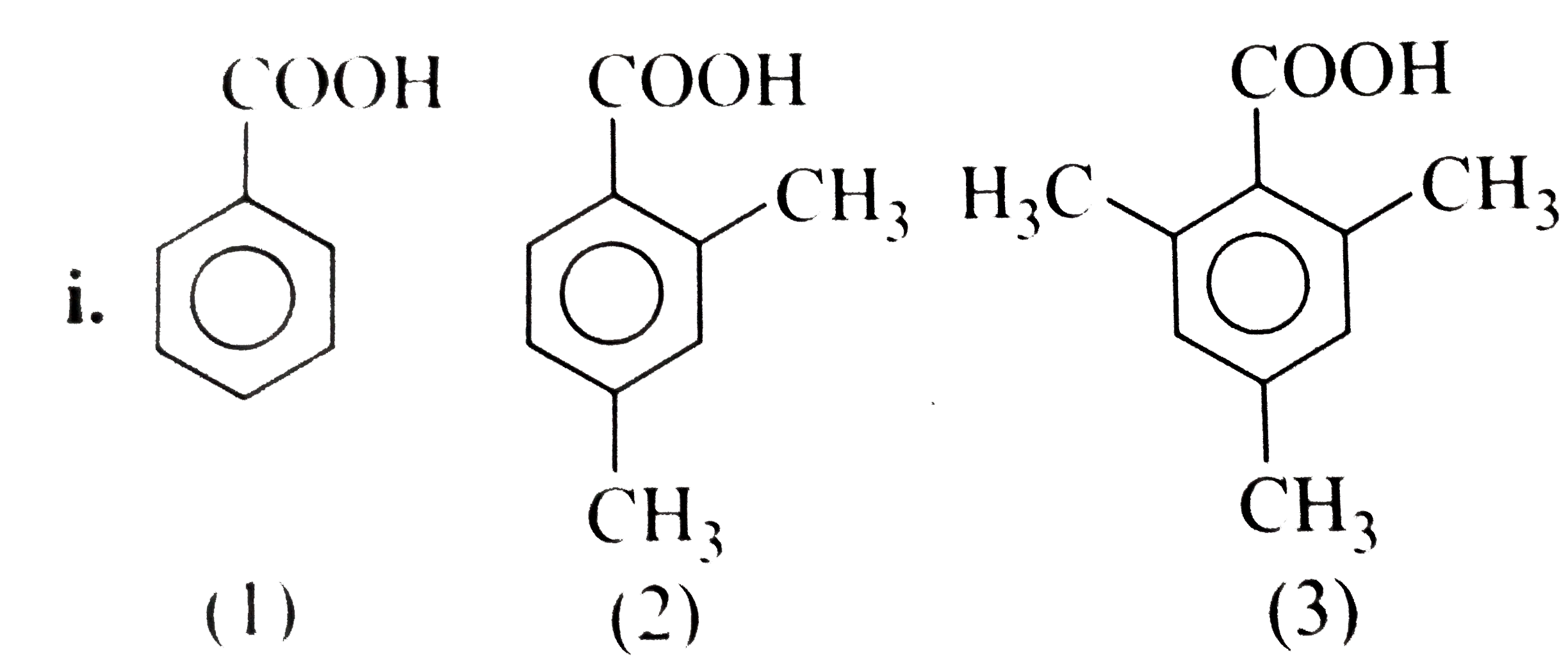Basicity of CH3CH2NH2(I),CH3CONH2(II)andC6H5CONH2(III) follows the order:
I>II>III
I>III>II
II>III>I
III>II>I
The correct Answer is:B
To determine the basicity of the compounds CH3CH2NH2 (ethylamine), CH3CONH2 (acetamide), and C6H5CONH2 (benzamide), we need to analyze the structure and electronic effects in each compound.
Step 1: Identify the Compounds
- Compound I: Ethylamine (CH3CH2NH2)
- Compound II: Acetamide (CH3CONH2)
- Compound III: Benzamide (C6H5CONH2)
Step 2: Analyze Basicity
Basicity in amines and amides is primarily determined by the availability of the lone pair of electrons on the nitrogen atom.
1. Ethylamine (CH3CH2NH2):
- The nitrogen atom has a lone pair that is localized and readily available for protonation.
- Alkyl groups are electron-donating, which increases the electron density on nitrogen, enhancing its basicity.
2. Acetamide (CH3CONH2):
- The lone pair on nitrogen can participate in resonance with the carbonyl group (C=O).
- This resonance delocalizes the lone pair, making it less available for protonation compared to ethylamine. Thus, it is less basic than ethylamine.
3. Benzamide (C6H5CONH2):
- Similar to acetamide, the lone pair on nitrogen is also delocalized due to resonance with the carbonyl group.
- Additionally, the benzene ring can further delocalize the lone pair, reducing its availability even more than in acetamide. Therefore, benzamide is the least basic among the three.
Step 3: Order of Basicity
Based on the analysis:
- Most Basic: Ethylamine (CH3CH2NH2)
- Moderately Basic: Acetamide (CH3CONH2)
- Least Basic: Benzamide (C6H5CONH2)
Thus, the order of basicity is:
CH3CH2NH2>CH3CONH2>C6H5CONH2
Final Answer
The basicity follows the order:
CH3CH2NH2>CH3CONH2>C6H5CONH2
---
- Compound I: Ethylamine (CH3CH2NH2)
- Compound II: Acetamide (CH3CONH2)
- Compound III: Benzamide (C6H5CONH2)
Basicity in amines and amides is primarily determined by the availability of the lone pair of electrons on the nitrogen atom.
- The nitrogen atom has a lone pair that is localized and readily available for protonation.
- Alkyl groups are electron-donating, which increases the electron density on nitrogen, enhancing its basicity.
- The lone pair on nitrogen can participate in resonance with the carbonyl group (C=O).
- This resonance delocalizes the lone pair, making it less available for protonation compared to ethylamine. Thus, it is less basic than ethylamine.
- Similar to acetamide, the lone pair on nitrogen is also delocalized due to resonance with the carbonyl group.
- Additionally, the benzene ring can further delocalize the lone pair, reducing its availability even more than in acetamide. Therefore, benzamide is the least basic among the three.
Based on the analysis:
- Most Basic: Ethylamine (CH3CH2NH2)
- Moderately Basic: Acetamide (CH3CONH2)
- Least Basic: Benzamide (C6H5CONH2)
CH3CH2NH2>CH3CONH2>C6H5CONH2
The basicity follows the order:
CH3CH2NH2>CH3CONH2>C6H5CONH2
Topper's Solved these Questions
- ORGANIC COMPOUNDS CONTAINING NITROGENBOOK - PRADEEPCHAPTER - ORGANIC COMPOUNDS CONTAINING NITROGENEXERCISE - COMPETITION FOCUS JEE (MAIN AND ADVANCED)/MEDICAL ENTRANCE SPECIAL (MULTIPLE CHOICE QUESTIONS-II)
5 Videos
- ORGANIC COMPOUNDS CONTAINING NITROGENBOOK - PRADEEPCHAPTER - ORGANIC COMPOUNDS CONTAINING NITROGENEXERCISE - COMPETITION FOCUS JEE (MAIN AND ADVANCED)/MEDICAL ENTRANCE SPECIAL (MULTIPLE CHOICE QUESTIONS-III COMPREHENSION TYPE)
9 Videos
- ORGANIC COMPOUNDS CONTAINING NITROGENBOOK - PRADEEPCHAPTER - ORGANIC COMPOUNDS CONTAINING NITROGENEXERCISE - VALUE BASED QUESTIONS WITH ANSWERS
3 Videos
- HALOALKANES AND HALOARENESBOOK - PRADEEPCHAPTER - HALOALKANES AND HALOARENESEXERCISE - IMPORTANT QUESTIONS FOR BOARD EXAMINATION
22 Videos
- P-BLOCK ELEMENTS BOOK - PRADEEPCHAPTER - P-BLOCK ELEMENTS EXERCISE - IMPORTANT QUESTIONS FOR BOARD EXAMINATION
25 Videos
Similar Questions
a. Acid halides, anhydrides, esters and amides, all of them contain (C=O) group but none of them gives test for (C=O) group, i.e., they do not form oximes, hydrazones, and DNP derivatives, etc. Why?
b. Arrange the following in the decreasing order of nucleophilic addition.
i. (1)−CHO
(2)−COCH3
(3)−COOH
(4)−COCI
(5)−CONH2
(6)−COOCH3
(7)−COOΘ
ii. (1)CH3CHO
(2)CH3COCH3
(3)HCHO
(4)CH2H5CH2COCH3
iii. (1)CH3COCH3
(2)C6H5COCH3
(3)C6H5COC6H5
(4)C6H5CH2COCH3
iv. (1)C6H5CHO
(2)ρ−CH3.C6H4.CHO
(3)ρ−OH.C6H4.CHO
(4)ρ−NO2.C6H4.CHO
(5)ρ−CI.C6H4.CHO
v. (1)HCHO
(2)CH3CHO
(3)CH3COCH3
(4)CI3CCHO
c. Arrange the following in the increasing order of ease of hydrolysis.
(1)CCH3COOC2H5
(2)CH3COCI
(3)(CH3CO)2O
(4)CH3CONH2
d. Arrange the following in the increasing order of ease of acid-catalysed esterification of:
i.
ii. (1)CH3CH2COOH
(2)(CH3)2CHCOOH
(3)(CH3)3CCOOH
iii. (1)CH3CH2CH2OH
(2)CH3CHOHC2H5
(3)(CH3)2C(OH)C2H5
e. Arrange the following esters in decresing order of ease of alkaline hydrolysis.
i. (1)HCOOCH3
(2)CH3COOCH3
(3)(CH3)3CCOOCH3
(4)(CH3)2CHCOOCH3
ii. (1)CH3COOCH3
(2)CH3COOC(CH3)3
(3)CH3COOCH(CH3)2
(4)CH3COOCH2CH3
iii. (1)C6H5COOCH3
(2)ρ−CH3O−C6H4−CCOOCH3
(3)ρ−NO2−C6H4−COOCH3
(4)ρ−Cl−C6H4−COOCH3
View SolutionIncreasing order of basic nature of
NH3(I),CH3NH2(II)andC6H5NH2(III) is
View Solution
Knowledge Check
CH3CH2CONH2X−−→CH3CH2CH2NH2
X is:APt/H2BNi/H2CLiAIH4DZnN2 gas is liberated when [HCl+NaNO2] reacts with the following compound
CH3CH2NH2
urea
CH3CONH2
C6H5NH2
The answer isAA,B,CBA,B,D,CA,C,DDB,C,DArrange the following in increasing order of their basic strength CH3NH2(I),(CH2NH(II),(CH3)3N(III),C6H5CH2NH2(IV) .
AIV<III<II<IBIV<III<I<IICI<II<III<IVDIV<I<II<III
Arragne basicity of the following compounds in decreasing order:
CH3CH2NH2(I), H2C=CH−NH2(II),
HC≡C−NH2(III), C6H5NH2(IV)
View SolutionArrange the following in increasing order of their basic strength CH3NH2(I),(CH2NH(II),(CH3)3N(III),C6H5CH2NH2(IV) .
View SolutionArrange the following : CH3NH2(I),(CH3)2NH(II),C6H5NH2(III) and (CH3)3N(IV) in increasing order of basicity in aqueous medium
View SolutionThe order of decreasing stability of the carbanions :
(CH3)3C−(I),(CH3)2CH−(II),CH3CH−2(III),C6H5CH−2(IV) is
View SolutionAmong the amines (a) C6H5NH2 (b) CH3NH2 (c) (CH3)2NH (d) (CH3)3N the order of basicity is
View Solution
